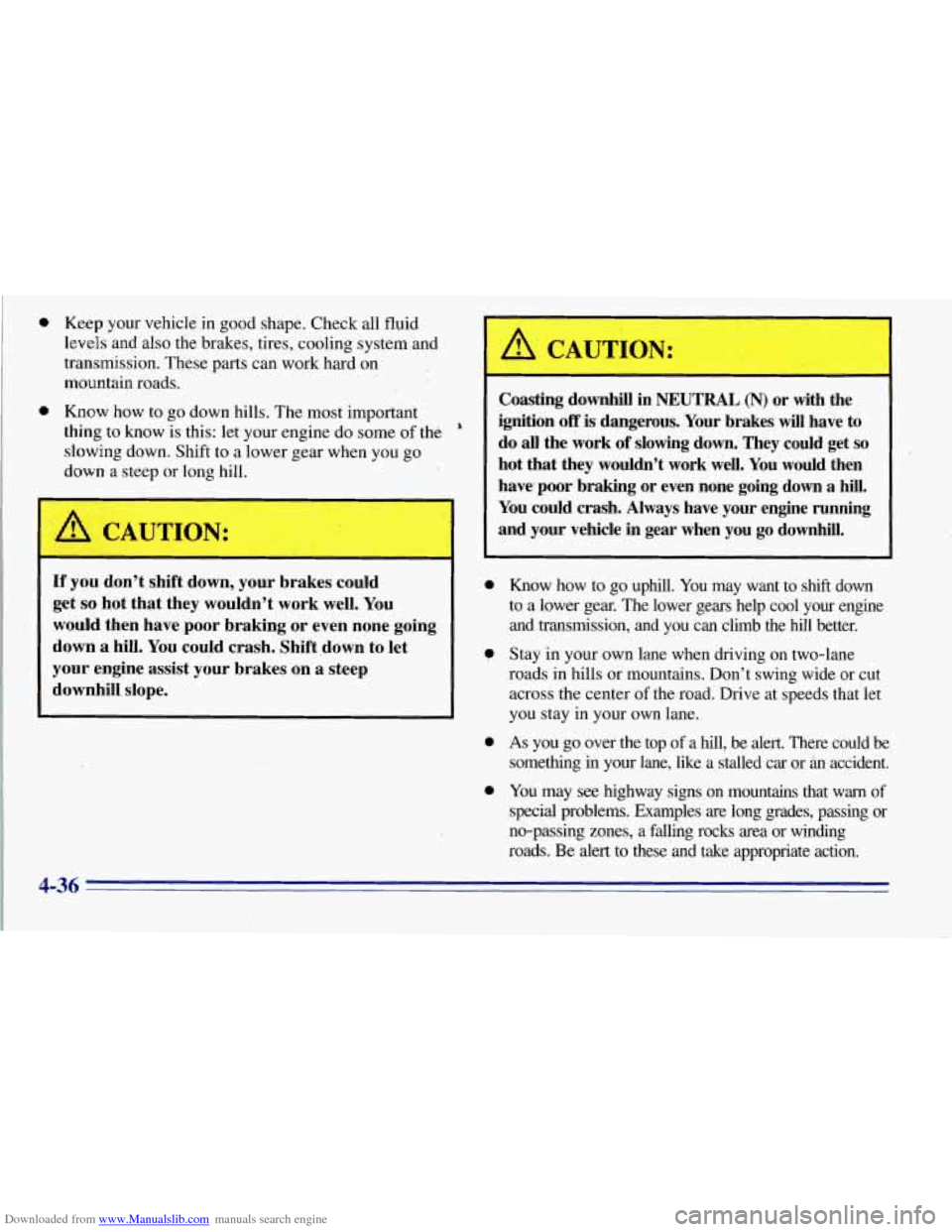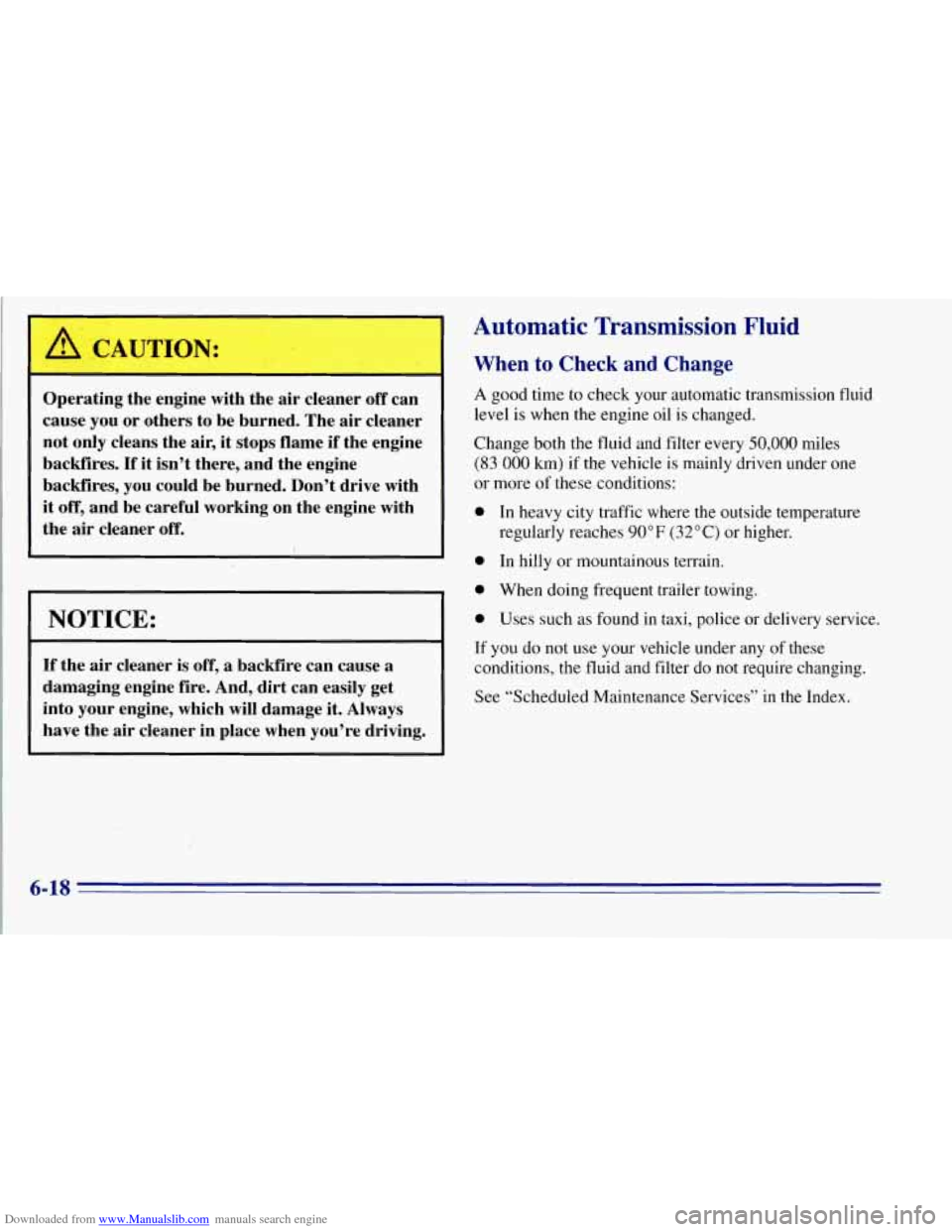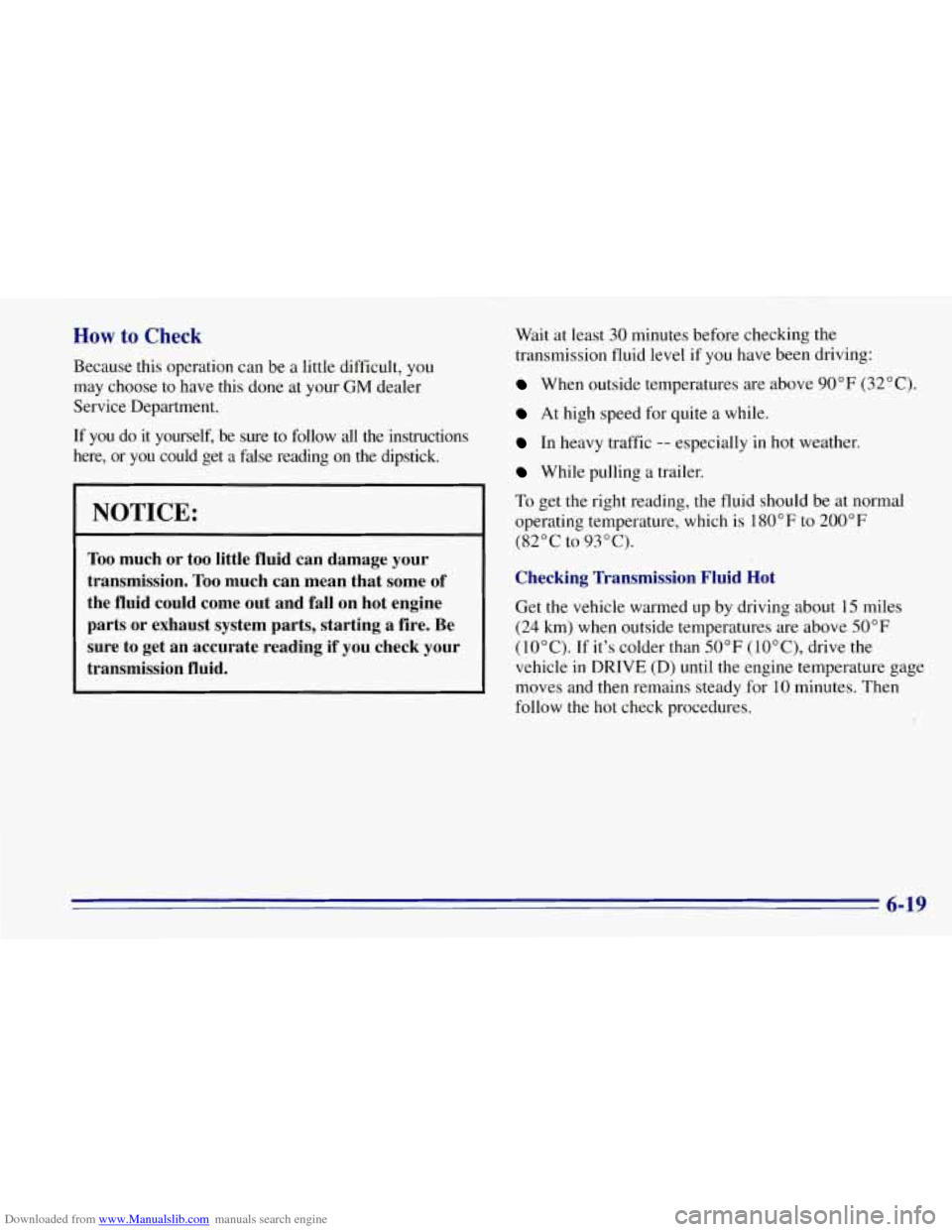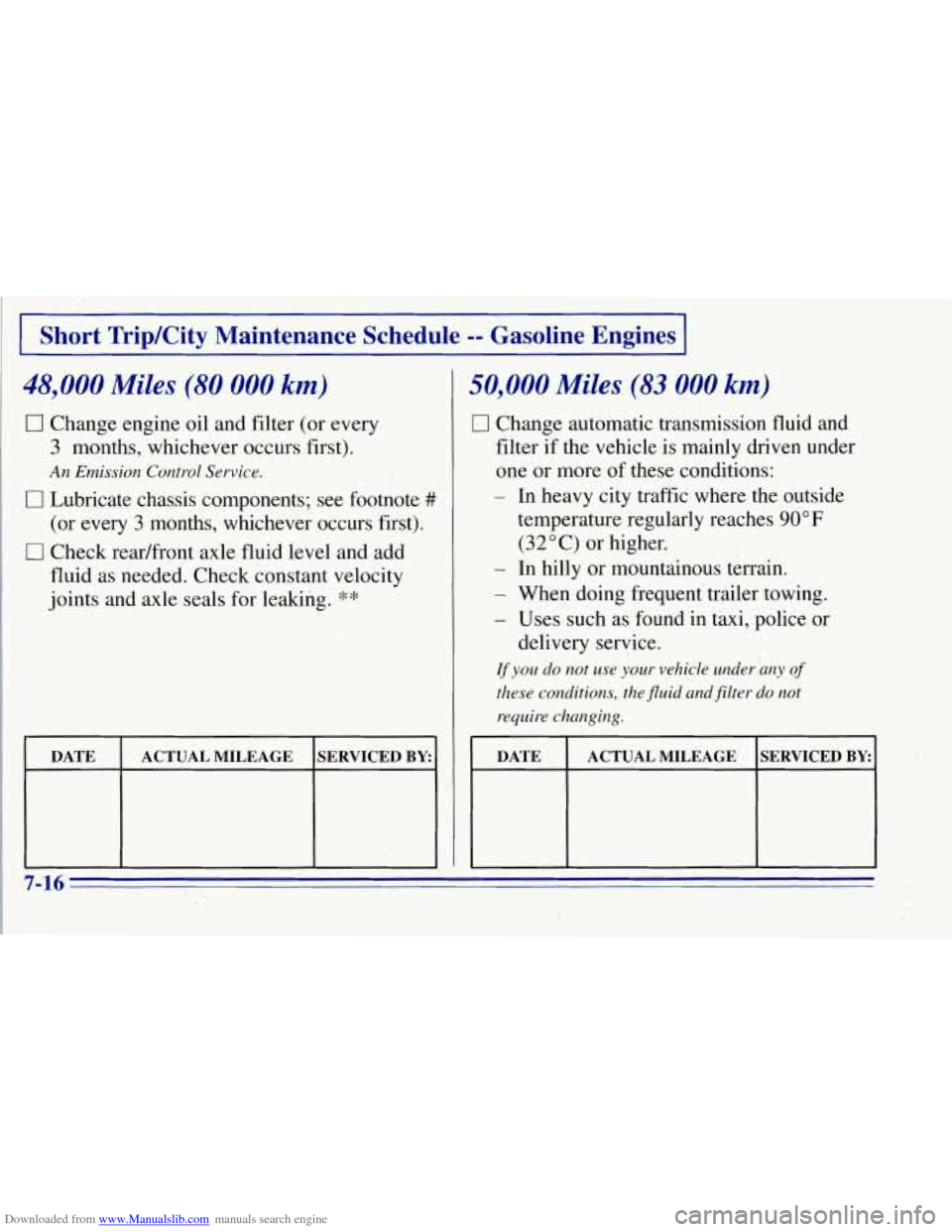1996 CHEVROLET TAHOE check transmission fluid
[x] Cancel search: check transmission fluidPage 195 of 403

Downloaded from www.Manualslib.com manuals search engine 0 Keep your vehicle in good shape. Check all fluid
levels and also the brakes, tires, cooling system and
transmission. These parts can work hard on
mountain roads.
Know how to go down’hills. The most important
thing to know is this: let your engine do some
of the
slowing down. Shift to’a lower gear when
you go
down a steep or long hill.
b
- -
A CAUTION: I
-
If you don’t shift down, your brakes could
getso hot that they wouldn’t work well. You
would then have poor braking or even none going
down
a hill. You could crash. Shift ,down to let
your engine assist your brakes on
a steep
downhill, slope.
A CAUTION:
I
Coasting downhill in NEUTRAL (N) or with the
ignition
off is dangerous. Your brakes will have to
do
all the work of slowing down. They could get so
hot that they wouldn’t work well. You would then
have.poor braking or even none going down a
hill.
You could crash. Always have your engine running
and your vehicle
in gear when you go downhill.
Know how to go uphill. You may want to shift down
to a lower gear. The lower gears help cool your engine
and transmission, and you can. climb
the hill better.
f Stay in your own lane when driving on two-lane
roads in hills or mountains. Don’t swing wide
or cut
across the center
of the road. Drive at speeds that let
you stay in your
own lane.
As you go over the top of a hill, be alert. There could be
something in your lane, like
a stalled car or iin accident.
You may see highway signs
on mountains that warn of
special problems. Examples are long grades, passing or
no-passing zones, a falling rocks area or winding
roads. Be
alert to these and take appropriate action.
4-36
Page 212 of 403

Downloaded from www.Manualslib.com manuals search engine When You Are Ready to Leave After
Parking on a Hill
1. Apply your regular brakes and hold the pedal down
while you:
0 Start your engine;
Shift into a gear; and
Release the parking brake.
2. Let ,up on the brake pedal.
3. Drive slowly until the trailer is clear of the chocks.
4. Stop and have someone pick up and store the chocks.
Maintenance When Trailer Towing
Your vehicle will need service more often when you’re
pulling a trailer. See the Maintenance Schedule for more
on this. Things that are especially important in trailer
operation are automatic transmission fluid (don’t overfill), engine oil, axle lubricant, belt, cooling system
and brake adjustment. Each
of these is covered in this
manual, and the Index will help you find them qoickly.
If you’re trailering, it’s a good idea to review these
sections before you start your trip.
Check periodically to see that all hitch nuts and bolts
are tight.
Trailer Wiring Harness
A seven-wire harness is stored under the rear of your
vehicle, between the frame rails. An electrical connector
will need to be added at the trailer end
of the harness, by
a qualified electrical technician. For additional trailer
wiring and towing information, please consult your
dealer. Securely attach the harness to the trailer, then
tape or strap it to your vehicle’s frame rail. Be
sure you
leave it loose enough so the wiring won’t bind or break
when turning with the trailer, but not
so loose that it
drags on the ground. Store’ the harness in its original
position. Wrap the harness together and tie it neatly
so it
won’t be damaged.
If you tow a trailer, your Center
High-Mounted Stoplamp (CHMSL) may not be
properly visible from behind.
You should select a trailer
with a CHMSL on
it or, if one is not available, have one
installed. See your GM dealer about how to connect
your vehicle’s wiring to a trailer CHMSL.
4-53
Page 271 of 403

Downloaded from www.Manualslib.com manuals search engine A ,CAUTION:
Operating the engine with the air cleaner off can
cause
you or others to be burned. The air cleaner
not only cleans the air, it stops flame
if the engine
backfires.
If it isn’t there, and the engine
backfires, you could be burned. Don’t drive with
it
off, and be careful working on the engine with
the air cleaner off.
I
NOTICE:
If the air cleaner is off, a backfire can cause a
damaging engine fire. And, dirt can easily get
into your engine, which will damage
it. Always
have the air cleaner in place when you’re driving.
Automatic Transmission Fluid
When to Check and Change
A good time to check your automatic transmission fluid
level
is when the engine oil is changed.
Change both the fluid and filter every
50,000 miles
(83 000 Ism) if the vehicle is mainly driven under one
or,more of these conditions:
0 In heavy city traffic where the outside temperature
regularly reaches
90” F (32 O C) or higher.
0 In hilly or mountainous terrain.
0 When doing frequent trailer towing.
0 Uses such as found in taxi, police or delivery service.
If you do not use your vehicle under any of these
conditions, the fluid and filter do not require changing.
See “Scheduled Maintenance Services” in
the Index.
6-18
Page 272 of 403

Downloaded from www.Manualslib.com manuals search engine How to Check
Because this operation can be a little difficult, you
may choose to have this done at your GM dealer
Service Department.
If you do it yourself, be sure to follow all the instructions
here, or you could get a false reading on the dipstick.
NOTICE:
Too much or too little fluid can damage your
transmission.
Too much can mean that some of
the fluid could come out and fall on hot engine parts or exhaust system parts, starting a fire. Be
sure to get an accurate reading if
you check your
transmission fluid.
Wait at least 30 minutes before checking the
transmission fluid level if you have been driving:
When outside temperatures are above 90°F (320C).
At high speed for quite a while.
In heavy traffic -- especially in hot weather.
While pulling a trailer.
To get the right reading, the fluid should be at normal
operating temperature, which is
180°F to 200°F
(82°C
to 93°C).
Checking Transmission Fluid Hot
Get the vehicle warmed up by driving about 15 miles
(24 km) when outside temperatures are above 50°F
(10°C). If it's colder than 50°F ( lO"C), drive the
vehicle in
DRIVE (D) until the engine temperature gage
moves and then remains steady for
10 minutes. Then
follow the hot check procedures.
6-19
Page 273 of 403

Downloaded from www.Manualslib.com manuals search engine Checking Transmission Fluid Cold
A cold check is made after the vehicle has been sitting
for eight hours or more with the engine off and is used
only
as a reference. Let the engine run at idle for five
minutes if outside temperatures are
50°F ( 10°C) or
more.
If it's colder than 50°F ( lO"C), you may have to
idle the engine longer. Should the fluid level be low
during a cold check, you
must perform a hot check
before adding fluid. This will give you
a more accurate
reading
of the fluid level.
Checking the Fluid Hot or Cold
Park your vehicle on a level place. Keep the
engine running.
With the parking brake applied, place the shift lever
in PARK (P).
With your foot on the brake pedal, move the shift
lever through each gear range, pausing for about
three seconds
in each range. Then, position the shift
lever
in PARK (P).
Let the engine run at idle for three minutes or more. Then,
without shutting off the engine, follow
Lhese steps:
1. Flip the handle up and then pull out the dipstick and
wipe it with
a clean rag or paper towel.
2. Push it back in all the way, wait three seconds and
then pull it back out again.
6-20
Page 274 of 403

Downloaded from www.Manualslib.com manuals search engine How to Add Fluid
Refer to the Maintenance Schedule to determine what
kind
of transmission fluid to use. See “Recommended
Fluids and Lubricants” in the Index.
Add fluid only after checking the transmission fluid
HOT. (A COLD check is used only as a reference.)
.If the fluid level is low, add only enough of the proper
fluid to bring the level up to
the HOT area for a hot
check. It doesn’t take
much fluid, generally less than a
pint
(0.5 L). Don ’t ovetjill. We recommend you use only
fluid labeled DEXR0N’-III, because fluid with that
3. Check both sides of the dipstick, and read-the lower label is made especially for your automatic transmission.
level. The fluid level IINLSt be in the COLD area for a Damage cauwd by fluid other than DEXRO;N-III
is not
cold check or in the HOT area or cross-hatched area covered b\
y
your new vehicle warranty.
for a hot check.
After adding fluid, recheck the fluid level as 4. If the fluid level is in the acceptable range, push the
dipstick back in all the way; then flip the handle
down to lock the dipstick in place.
whin the correct fluid level is obtained, push the
described under “How to Check.”
dipstick back in all the way; then flip the handle
down to lock the dipstick in place.
’
6-21
Page 333 of 403

Downloaded from www.Manualslib.com manuals search engine I Short Trip/City Maintenance Schedule -- Gasoline Engines
The services shown in this schedule up to 100,000 miles
( 166 000 km) should be performed after 100,000 miles
(166 000 km) at the same intervals.
Footnotes
The U.S. Environmental Protection Agency or the
California Air Resources Board has determined that
the failure to perform this maintenance item will
not
nullify the emission warranty or limit recall liability
prior to the completion
of the vehicle's useful life.
We, however, urge that all recommended
maintenance services
be performed at the indicated
intervals and the maintenance be recorded.
# Lubricate the front suspension, kingpin bushings,
steering linkage, transmission shift linkage, transfer
case shift linkage, parking brake cable guides, front
axle propshaft splines and brake pedal springs. Ball
joints and kingpin bushings should not be lubricated
unless their temperature
is 10°F (-12"C), or higher,
or they could be damaged.
** Drive axle service:
0 Locking Differential -- Drain fluid and refill at first
engine oil change. At subsequent oil changes, check
fluid level and add fluid as needed. If driving in
dusty areas or towing a trailer, drain fluid and refill
every
15,000 miles (25 000 km).
Standard Differential -- Clieck fluid level and add
fluid as needed at every oil change. If driving in
dusty areas or towing a trailer, drain fluid and refill
every
15,000 miles (25 000 km).
0 More frequent lubrication may be required for
heavy-duty or off-road use.
7-6
Page 343 of 403

Downloaded from www.Manualslib.com manuals search engine Short TripKity Maintenance Schedule -- Gasoline Engines
48,000 Miles (80 OOOkm)
0 Change engine oil and filter (or every
3 months, whichever occurs first).
An Emission Control Service.
0 Lubricate chassis components; see footnote ##
(or every 3 months, whichever occurs first).
0 Check readfront axle fluid level and add
fluid as needed. Check constant velocity
joints and axle seals for leaking.
**
50,000 Miles (83 000 km),
0 Change automatic transmission fluid and
filter if the vehicle is mainly driven under
one
or more of these conditions:
- In heavy city traffic where the outside
temperature regularly reaches
90 O F
(32°C) or higher.
- In hilly or mountainous terrain..
- .When doing frequent trailer towing.
- Uses such as found in taxi, police or
If you do not use your vehicle under any of
these conditions, the
fluid and filter do not
require changing.
delivery service.
DATE
SERVICED BY: ACTUAL MILEAGE
7-16 ’